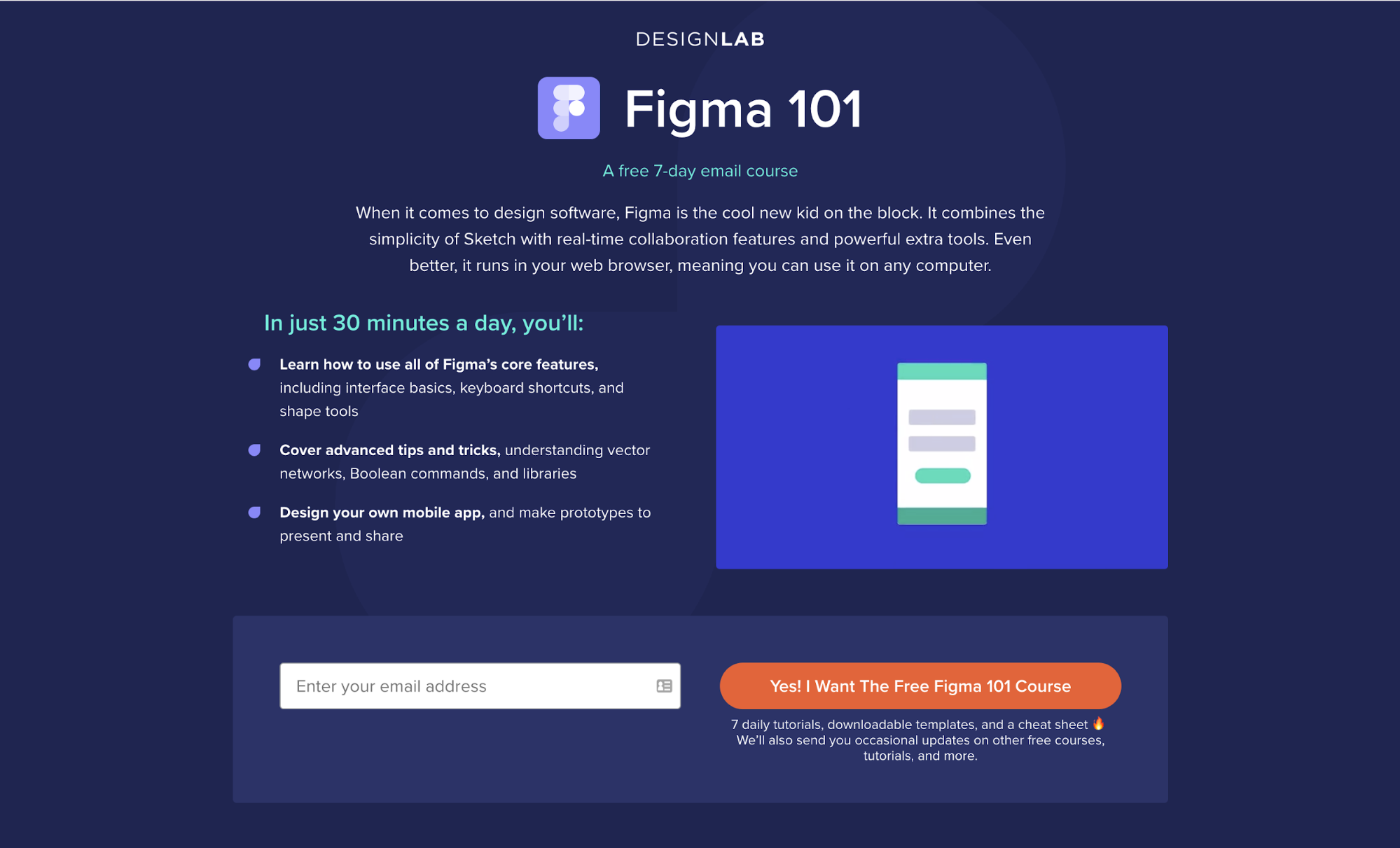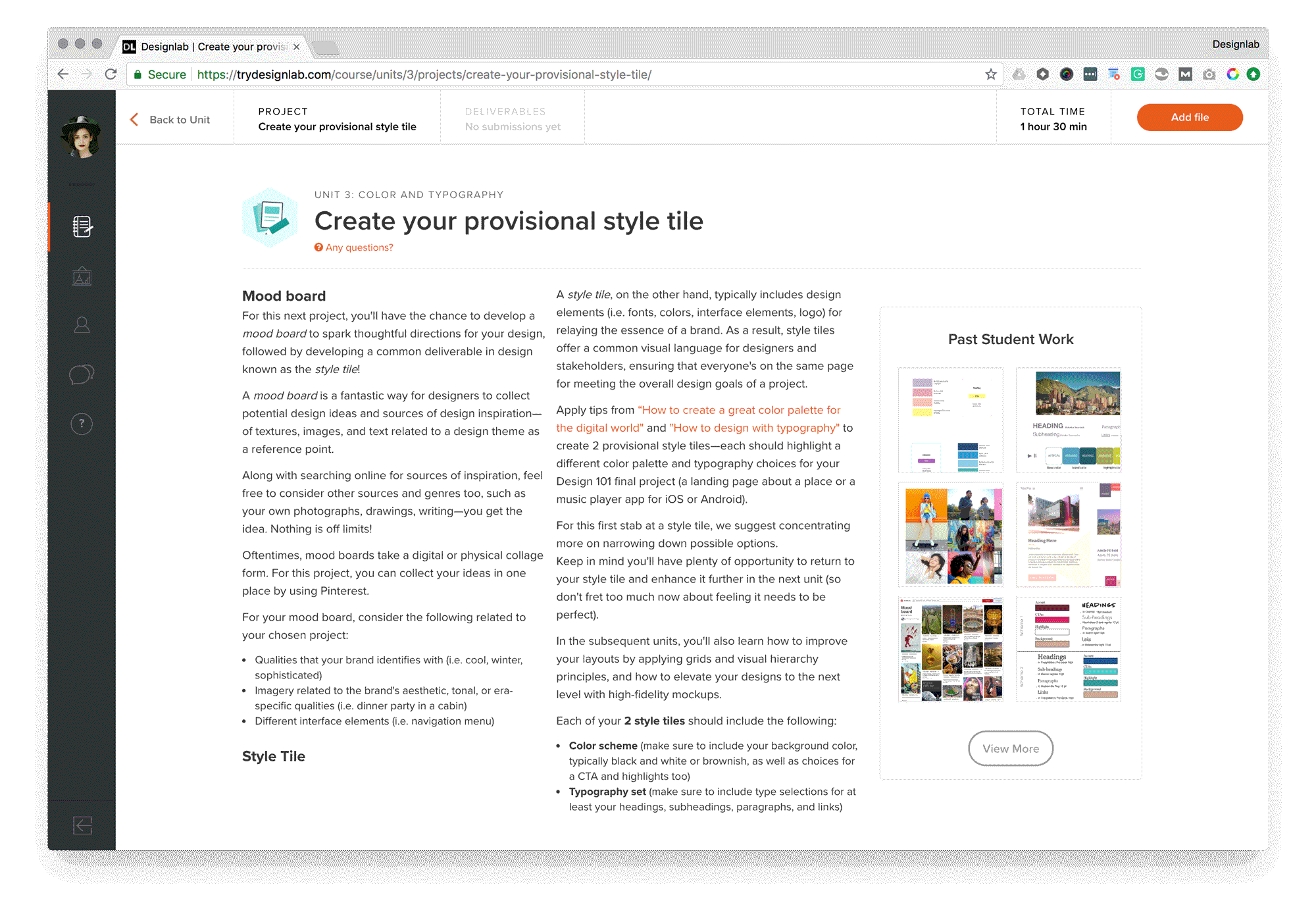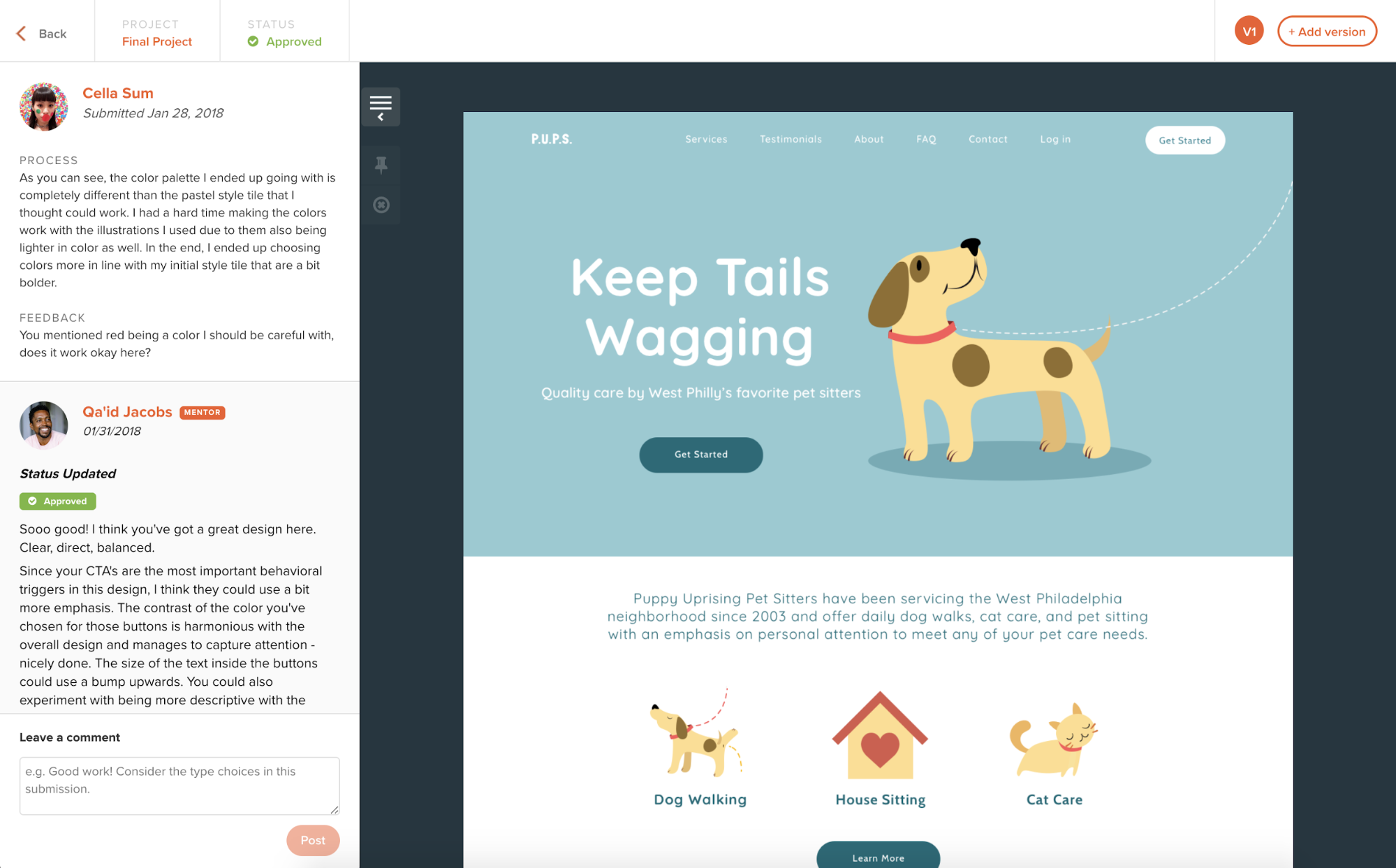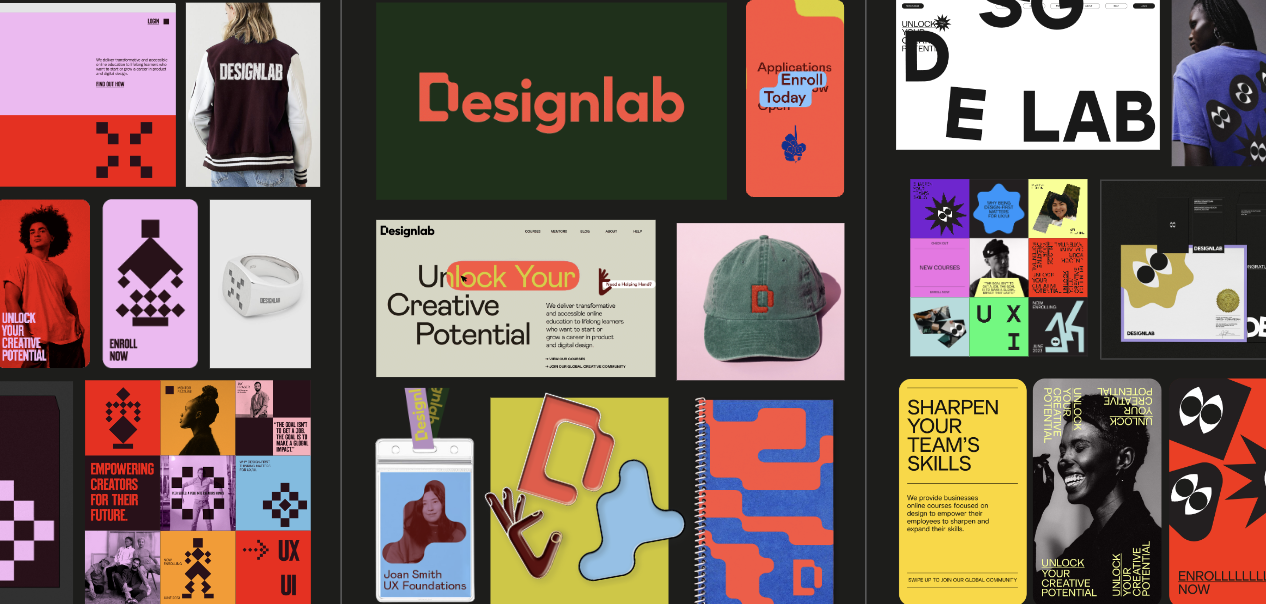Amid much excitement here at Designlab, we announced a huge update to our most popular 4-week course, Design 101.
Our focus throughout this overhaul was on quality: how can we make this the best course possible for getting a rigorous introduction to design fundamentals—in just 4 weeks?
The original Design 101 curriculum had served thousands of students well, but its projects had a focus on desktop landing pages, which had become outdated in a mobile-first world.
So we rebuilt both the course structure and the course content from scratch. You can read full details of the Design 101 relaunch here.
If you’re still on the fence about learning design, read on for an in-depth look at the new course. This piece covers many of the ways our bespoke learning platform combines with top-notch Design 101 curriculum and 1-on-1 mentoring to deliver a unique educational experience.
1. The In-House Bespoke Designlab Learning Platform

Over the past five years, we’ve built a bespoke learning platform that is exclusively available to Designlab students. It’s a one-stop shop for working through the curriculum content, completing exercises, projects, and quizzes, discussing questions with the student community, uploading work, and getting feedback from your mentor!
2. Access To Our Top-Notch Design Software Tutorials

It’s very common for design beginners to worry about being able to use software like Sketch, Photoshop and Illustrator. The good news is that design isn’t just about software. In fact, software is just a tool to execute an idea—the real work of design is in thinking, problem-solving, and iterating on solutions.
Having said that, getting to grips with the basics of industry-standard software is, of course, essential for any designer. At the start of all Designlab courses, you have access to any of our free email courses and tutorials, which cover Sketch, Photoshop, Illustrator, and now the awesome new browser-based design tool, Figma.
3. Unboxing Design 101 And Getting Started On The Coursework

Many Designlab graduates tell us about the day they opened up their first Designlab course. For some, it was their first day of formal design education after spending years of making a hobby from self-teaching design. For others, it turned out to be the first step on a longer journey towards becoming a design professional, and building a future in the industry.
Here’s what Andrew had to say about his Design 101 experience:
“After years wondering how I could escape my admin job, I clearly remember the day (February 5th, 2016) I came home and started work on my first landing page design. It was a breath of fresh air, and the start of a whole new career.”
4. Scrolling Through The 8 Juicy Jam-Packed Design Units

By the end of Design 101, you won’t believe quite how much you’ve covered—and even how your way of seeing the world has changed. Once you’ve learned to identify good alignment, beautiful type, and effective visual hierarchy, you’ll start seeing the bad stuff everywhere! (Warning: there’s No. Going. Back.)
5. Setting Your Goals For The Course

The new Design 101 curriculum kicks things off by asking you to set your goals. If you’ve ever wondered about learning design, this is something you could do right now now. Grab a piece of paper, and ask yourself: Why do you want to learn design? What kind of projects are you most excited by? How do you plan to apply your new learning? What specific skills do you want to gain?
6. Super In-Depth, In-House Content

After that icebreaker, it’s time to dive into one of the amazing new in-depth lessons in Design 101. In the GIF above, we’re scrolling through a piece on the history of design movements through the centuries! We actually wrote so much cool stuff that we had to make some of it optional, but if you’re a huge design nerd like us... you’re welcome.
7. New Extra Actionable How-To Guides

Design is a creative discipline that solves real-world problems. So abstract, theoretical knowledge about design is no good if you don’t know how to apply it. That’s a truth that we’ve reflected in the checklists, how-to guides, and other extras that we’ve crammed into the new Design 101. Extra-actionable content like this guide on how to evaluate design is just one of our new content formats!
8. Notebook Exercises FTW

As well as the formal projects, Design 101 now also comes bundled with a bunch of notebook exercises—short, informal diversions that allow you to explore and consolidate a new skill in a slightly different way. They’re useful practice… and a great way to fill up your current sketch book so you can start that new one you just bought 🎉
9. Quizzes That Help You Track Your Learning

Sometimes, you think you’ve taken something in, but it’d be good to check, right? We’ve now integrated a series of optional self-assessment quizzes. They’re not tests—just opportunities to see if you got that last lesson, and to find out if there are any gaps.
10. Rapidly Grasping Graphic Design And Usability Basics

Follow up that long read on design history with some bitesize lessons covering some design fundamentals and usability principles! When we set out to redesign the Design 101 curriculum, we analyzed every single lesson idea and identified the most crucial points for you to grasp as a design newbie. And so far, the feedback on the new course has been stellar.
11. Learn How To Come Up With Good Ideas

The archetypal image of a digital designer might be someone pushing pixels on a huge Apple Mac screen. But, truth be told, all that stuff designers do while sitting at the computer is only half of the story. Before they can start creating solutions with keyboard and mouse, they first need to have ideas to work with.
A big part of learning design is learning how to generate ideas rapidly, and then explore, develop, and discard them just as quickly. Design 101 now has a whole unit devoted to ideation and sketching. So grab a pencil and paper, step away from the computer, and let’s get lo-fi ✏️
12. Practical Pro Tips On Crafting Color Palettes

Color theory is a *huge* topic, and arguably it takes a whole career to master all the subtleties of how to choose and combine colors. The priority for a design beginner is to understand the fundamental ingredients of an effective color palette—especially for the kinds of project that today’s designer works on every day, like websites and apps.
13. The Joyful Moment Of Uploading An Assignment (And Another, And Another)

When you’ve spent an hour fretting over your color palette, making the decision—that it’s time to upload—can be pretty cathartic. This is also a great time to flag the points where you’d most like to get some feedback!
14. Four Hours Of 1-on-1 Video Calls With Your Expert Design Mentor

We’re delighted with the new Design 101 curriculum. BUT we still believe the biggest value point in Designlab courses is the unique combination of rigorous materials and personal, human-to-human, real-time mentoring through calls where you get to discuss your work, listen to feedback, ask questions, find out about the industry, and much more! Design 101 comes with 4 hours of 1-on-1 video sessions for you to focus on the detail. Check out some of our mentors here!
15. Thorough Written Feedback On The Platform

It’s not just about those weekly calls, though! Just as important is getting in the habit of uploading new work to the platform, so that you can get written feedback from your mentor. It also gives you the opportunity to “iterate” on each project—in design, iteration is the process of acting on feedback received and creating a revised version.
16. Completing The Course With An Awesome Final Project

One of the coolest things about the new Design 101 is that all the assignments you work on during the course create components for your final design. The final project pictured above is by Sam, a course graduate who had this to say about the new curriculum:
It is the best. As someone who went to school for education, it was really impressive to see the great care that was taken to create the lessons and materials. It’s certainly better than any online college course that I have ever taken. Al, my mentor, is top notch and I enjoy each of our calls. Overall, just seriously great.
17. The No-Questions-Asked 100% Money-Back Guarantee

We’re delighted to relaunch Design 101—and we believe that with its in-depth curriculum, hands-on projects, and mentor support, it’s the best available course for learning design fundamentals online. If you take the course and feel like you didn’t get the experience you expected, we’ll give you your money back. It’s as simple as that.
Check out Design 101!
Now that you’ve gone behind the scenes with our newly redesigned course, why don't you test it out yourself? Whether as an introduction to the field, a way to level up existing skills, or to kick off a new career, Design 101 is the perfect way to see what design is all about. Check it out!



.svg)







%20(1)-min.png)






